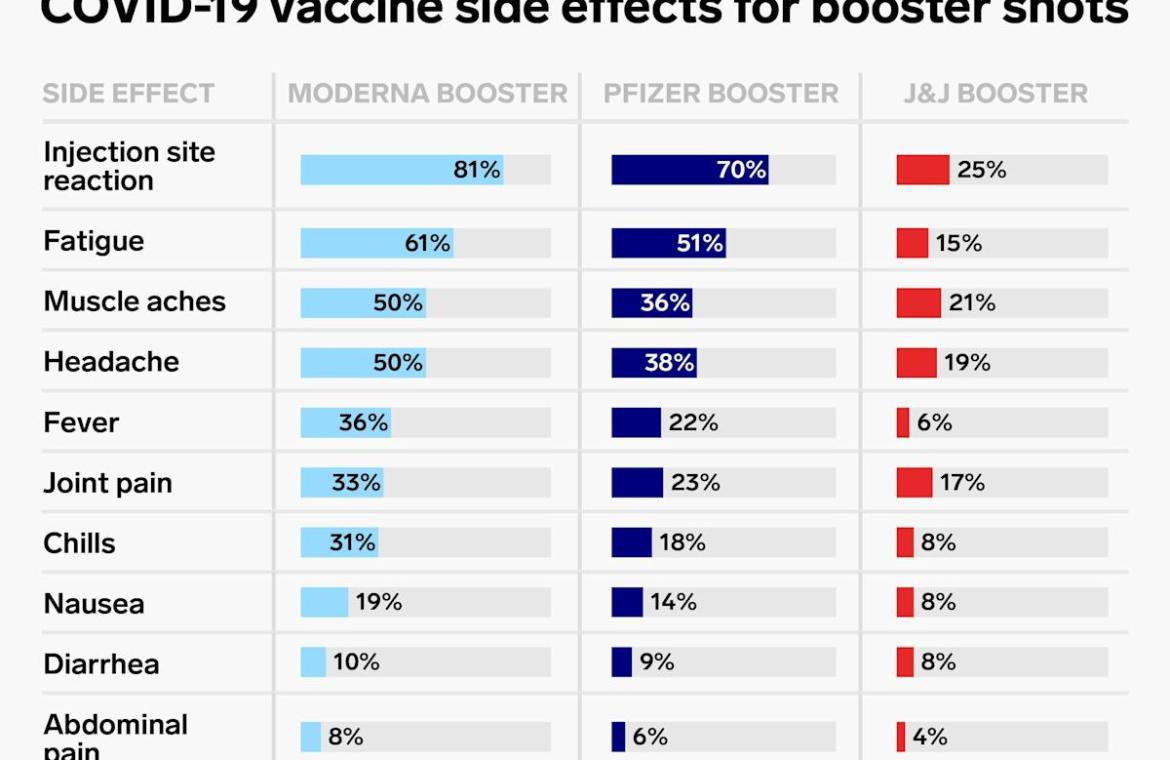A Thai healthcare employee receives a booster dose of Pfizer’s vaccine in Bangkok on August 9, 2021.Vichan Poti/Pacific Press/LightRocket through Getty Images
Second and third doses of COVID-19 vaccines typically produce related side effects however there are some slight variations.
In September, the Centers for Disease Control and Prevention (CDC) gave the first comparability between booster photographs of all three vaccines out there in the US: Pfizer and Moderna (each mRNA photographs), and Johnson & Johnson (an adenovirus vaccine).
It’s one in all the most complete seems to be at how individuals are responding to boosters to this point.
Broadly, the CDC discovered that individuals who’d acquired three doses of both Pfizer or Moderna noticed extra native reactions — ache, itchiness, redness, or swelling at the injection website — after dose three in comparison with dose two. Other side effects similar to fatigue, muscle aches, or complications had been much less common, affecting 74% after their third dose, in contrast with 77% after dose two.
A second dose of J&J’s vaccine yielded the fewest side effects of all: Only 10% of J&J booster recipients stated their side effects prevented them from performing regular day by day actions — normally on the day after their booster shot — whereas the relaxation stated they had been in a position to go about their day as regular.
By comparability, 28% of Pfizer or Moderna booster recipients stated the photographs hindered their day by day routine. However, the examine included way more information on mRNA boosters — 12,000 individuals, in comparison with 48 who acquired two J&J doses.
The following desk shows how booster photographs affected individuals who obtained three doses of Moderna, three doses of Pfizer, or two doses of Johnson & Johnson’s vaccine, in line with CDC information.
Aside from native reactions at the injection website, fatigue was most common amongst individuals who acquired a Pfizer or Moderna booster.
Story continues
Overall side effects had been extra prevalent after Moderna’s third dose: Half of Moderna booster recipients reported muscle aches and complications, and round 60% reported fatigue.
Meanwhile, lower than 40% of Pfizer booster recipients reported muscle aches and complications and round 50% reported fatigue.
Just one-quarter of those that acquired a J&J booster had injection website reactions, in contrast with 70% who obtained a Pfizer booster and 80% who obtained a Moderna booster. And 20% of J&J booster recipients reported muscle aches and complications.
The CDC recommends boosters for all adults and permits you to combine and match
The CDC now recommends booster photographs for all Americans ages 16 and older. People who acquired two doses of Pfizer’s or Moderna’s vaccine ought to get boosted no less than six months after their second shot, the CDC advises, whereas J&J recipients can get boosted as early as two months after their first dose.
The CDC has additionally accepted a “mix and match” strategy so individuals can choose a booster of a unique vaccine kind or totally different producer than their unique dose.
An October examine funded by the US National Institutes of Health (which has but to be peer-reviewed) discovered that blend and match boosters yielded related side effects to preliminary vaccine doses. More than half of the examine’s 458 contributors reported malaise, complications, and muscle aches after their booster whereas greater than 70% skilled delicate arm ache.
A UK examine equally recognized fatigue, complications, and ache at the injection website as the most common side effects. The examine checked out practically 2,900 individuals who had acquired two doses of Pfizer or AstraZeneca, adopted by one in all seven totally different COVID-19 boosters. Overall, side effects from boosters had been extra common in individuals ages 30 to 69 than these ages 70 and up, the examine discovered — no matter which vaccines the contributors acquired.
Fatigue, complications, and muscle tissues aches had been additionally common after first and second doses
The mRNA vaccines from Pfizer and Moderna instruct the physique to provide a innocent viral protein, then develop antibodies in opposition to it. The first dose of those vaccines typically produces the mildest side effects, since our our bodies are being launched to the directions and the ensuing protein for the first time.
By the time we obtain a second and third dose, our our bodies have discovered to acknowledge that protein rapidly, so are able to assault it. That’s why side effects are typically extra pronounced. (If you’ve got had COVID-19 earlier than, although, your first dose might yield extra intense side effects than your second or third, in line with one preprint.)
The following chart shows common vaccine side effects primarily based in your age group, vaccine producer, and which dose you acquired. Data is from every vaccine’s medical trial.
As with a booster shot, fatigue, complications, and muscle tissues aches had been common after doses one and two.
In common, older individuals expertise fewer side effects than youthful adults as a result of immune responses progressively weaken with age. That’s additionally the motive why older individuals are specifically want of boosters: While vaccines nonetheless shield in opposition to extreme illness for now, the Omicron variant appears to extend the threat of reinfection relative to different coronavirus strains.
It’s additionally higher than the unique virus at evading antibodies from two vaccine doses, early lab research counsel.
Read the unique article on Business Insider








